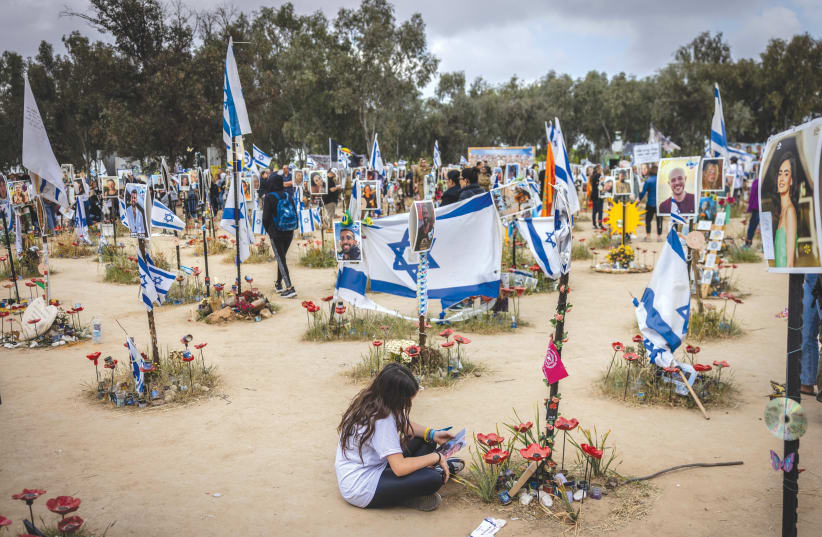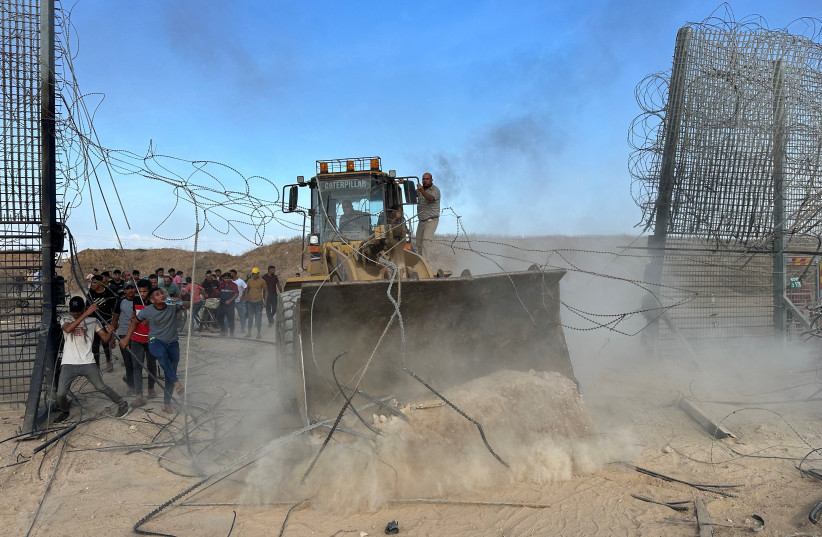Nightfall’s blackness, silence, and chill descended on the Re’im Forest as its treetops rustled with a familiar hiss.
Earlier, when the sun was setting where 364 music fans were massacred, human voices still echoed here as 80 American yeshiva students from Jerusalem formed a circle and sang solemnly the ancient prayer about “our brethren, the whole house of Israel who are in trouble and captivity,” and begged God to “have mercy on them” and “lead them from trouble to freedom and from darkness to light.”
Hundreds pilgrimage here daily, but now they were all gone. No one other than my reporter’s notebook was with me when I heard the rustle rise from the treetops to the star-strewn skies.
I knew the rustle. It was the same morbid whisper I heard in Latvia’s Rumbula and Lithuania’s Ponar, two of the forests where multitudes of Jews were machine-gunned in the Holocaust’s early days.
Everyone is harboring such thoughts these days. Not a day goes by without discussion of October 7 eliciting analogies to Jewish history’s countless massacres and pogroms.
Fitting October 7 into Jewish history
Now, as the most somber Independence Day since Israel’s establishment approaches, the question indeed arises: How does October 7 fit into Jewish history, what does it say about the Zionist idea, and what is its instruction to the Jewish state?
THE HISTORIANS’ debate has already begun.
“What happened on October 7 is very similar to the pogroms against the Jews,” ruled Hebrew University historian of Germany Moshe Zimmermann (“You must compare,” Haaretz, December 29, 2023).
“How did it happen,” he asked, “that the Zionist state… proved unable to realize the aims… that its founders assigned it?” before answering harshly: “The pogrom on Israel’s land… is a turning point in our assessment of Zionism’s success” because “once a pogrom is performed against Jews… in the Zionist state – the state and Zionism both attest that they failed,” since the pair’s guiding principle was “to prevent a situation like the one that the Jew faced in the [Jewish] Exile.”
The opposing school took less than a month to emerge.
“October 7 was not a repetition of the pogroms that happened in East Europe,” wrote Shmuel Feiner, Chairman of the Historical Society of Israel and historian of German Jewry at Bar-Ilan University.
The Western Negev massacre, reasoned Feiner, unfolded under circumstances that did not exist during the pogroms, like the confrontation between the superpowers or the existence of an “Israeli ethos” of tilling the soil, building an army, reviving Hebrew, and launching technological start-ups. “The blood libels, the Crusades, the Dreyfus Trial,” he thus argued, “belong in a historical world with its own context” (“Return of the context,” Haaretz, 25 January 2024).
Feiner is right. Previous anti-Jewish violence was different in its context, and even more so in its aftermath. Unlike the Crusaders’ massacres, which lasted two months, and unlike the pogroms of the Black Death, the Ukrainian-Polish War, or the Russian Civil War, which lagged for years, the 2023 pogrom ended in 24 hours, and not because its perpetrators got tired but because the Jews fought back, killed most of the invaders, and pursued the rest with infantry, artillery, armor, jets, and drones. That’s not what happened in Kishinev, Auschwitz, Rumbula, or Ponar.
And Zimmerman is wrong. Was Hamas’s invasion a grand Israeli failure? Of course it was, but it was a failure of leadership, not the failure of an idea. Just like Germany’s invasion of France and Japan’s attack on Pearl Harbor were not failures of the democratic idea, and just like Germany’s invasion of the Soviet Union was not a failure of the communist idea, Hamas’s invasion of Israel was not a failure of the Zionist idea.
So yes, on its 76th birthday, Israel is tested in a way it never was, but the test it faces does not resemble the tests the Jewish people faced after they lost their independence.
Instead, the test modern Israel faces is the one ancient Israel faced, and repeatedly failed, back when it was “great among nations” and “princess among states” as Judah’s refugees remembered their fallen state (Lamentations 1:1).
AS NOTED here previously (“Netanyahu’s last opportunity,” February 9, 2024), ancient Israel’s internal rifts resulted in four foreign invasions: first by Egypt, after the breakup between Judah and Israel; then by Aram, after the collapse of the alliance between kings Ahab and Jehoshaphat; then by Assyria, after the last war between Judah and Israel; and finally by Rome, during the civil war between Hasmonean brothers John Hyrcanus and Judah Aristobulus. This is besides the civil war that raged in Jerusalem while Titus approached its walls.
This little-known and underappreciated history of national strife and its exorbitant price is where the key lies to understanding, and undoing, Israel’s current crisis.
A nation divided from within invites invasion from without. Past Israeli leaders understood this.
That is why David Ben-Gurion forced the militias of both Right and Left into a unified IDF. That is why Levi Eshkol flew in the remains of Labor’s arch-rival Zeev Jabotinsky for a state funeral by Theodor Herzl’s tomb.
And that is why Yitzhak Shamir preferred a coalition with the political center over a narrow government with the far Right.
That is not what happened as October 7’s catastrophe approached.
In those days, we had a leadership that divided the people and undermined the state, besmirching its judges and hammering its courts.
This leadership will soon depart, and its successors will have to fix what it ruined. And that will mean recalling what Israeli history, like Jewish history before it, has just made plain: that when united, the Jews win; and when divided, they are slaughtered at will.
www.MiddleIsrael.netThe writer, a Hartman Institute fellow, is the author of the bestselling Mitzad Ha’ivelet Ha’yehudi (The Jewish March of Folly, Yediot Sefarim, 2019), a revisionist history of the Jewish people’s political leadership.

